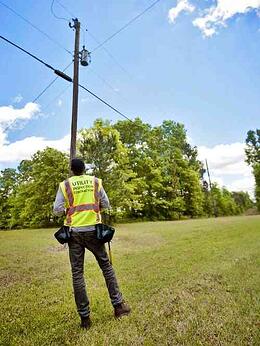Safety and Communication Challenges for Joint Use Utility Pole Owners
 The joint use of utility poles is a great solution to an important problem. A number of different companies want to place equipment in a certain geographic area to deliver their services to consumers. Power companies, cable companies, cell phone companies, and others, all need equipment placed around the areas they service. For each of them to erect and use their own utility poles is impractical and effectively impossible. The solution, therefore, is for one company to own the pole (the pole owner) and rent space on it to the other companies who need it (the pole attachers). Thus, everyone benefits from joint use.
The joint use of utility poles is a great solution to an important problem. A number of different companies want to place equipment in a certain geographic area to deliver their services to consumers. Power companies, cable companies, cell phone companies, and others, all need equipment placed around the areas they service. For each of them to erect and use their own utility poles is impractical and effectively impossible. The solution, therefore, is for one company to own the pole (the pole owner) and rent space on it to the other companies who need it (the pole attachers). Thus, everyone benefits from joint use.
Joint use arrangements are common and have certain challenges. The main challenge for the pole owner is to manage all attaching partner companies, keeping close eye on both the utility poles and the pole attachments. Overseeing all the “foreign” attachments compounds the responsibility of the pole owner and can lead to confusion, disorganization, and even danger if not well-managed. Here are a few safety and communication issues that owners of joint use utility poles may regularly face.
- Damaged Utility Poles. A number of things can structurally weaken wooden utility poles over time. Wood will eventually rot and develop internal cracks or holes. Rot is dangerous for a utility pole and may cause it to fall, leading to outages and possible damage to the surrounding area. Therefore, it is extremely important to guard against pole failure by scheduling regular inspections of the utility poles you own. This way, you can keep informed as to what pole assets need to be serviced or replaced, before a violation occurs.
- Utility Pole Overloading. This usually happens as a result of a lack of good communication with your joint use partners or “attachers.” If you cannot consistently account for which companies have what equipment on which utility poles, it is easy to see how one pole (or many) can end up with a larger load than the pole was meant to handle. This may also mean that companies are neglecting to get the proper attachment permits before adding their equipment to a given utility pole. Putting too much weight on a pole can weaken it, causing it to fail even if it is otherwise undamaged. To avoid this disastrous situation entirely, it is essential to stay well connected with all of your partner companies and ensure each pole has only as much as it can handle. Fortunately, there are solutions on the market today to do remove all barriers to communication, fostering better relationships between pole owners and attaching companies.
- Pole Transfers. When transferring attachments from an old utility pole to a new one, there are often companies that, for whatever reason, do not make the switch, resulting in double poles. Double poles, or “doublewood” is a situation where two utility poles, side by side, (usually with the pole “topped”) each bear some of the attachments. All attaching companies may not have received a Transfer Notice, or the notice may have been lost in a pile of paper or emails. Either way, a double pole situation is trouble. It is unsightly and can be dangerous.
Many of the issues associated with managing joint use utility poles (or conduits or cell towers, for that matter) can be quelled simply by improving communication between all the parties who jointly share the asset. In today’s world, you must stay connected with your partner companies, attachers, contractors and engineers. Every entity that jointly shares an asset, such as a utility pole, can and should always be in the loop on status of all work as a business best practice.
A joint use management system can keep everyone up to speed on what attachments are on which poles, which helps avoid overloading, and can help eliminate illegal or unpermitted attachments and violations in the field. With everyone informed about pole transfers, for example, double poles can be avoided entirely. Improving communication and thorough record-keeping is the best way to improve safety, and, ultimately, improve the way you manage the utility poles you own.

Comments